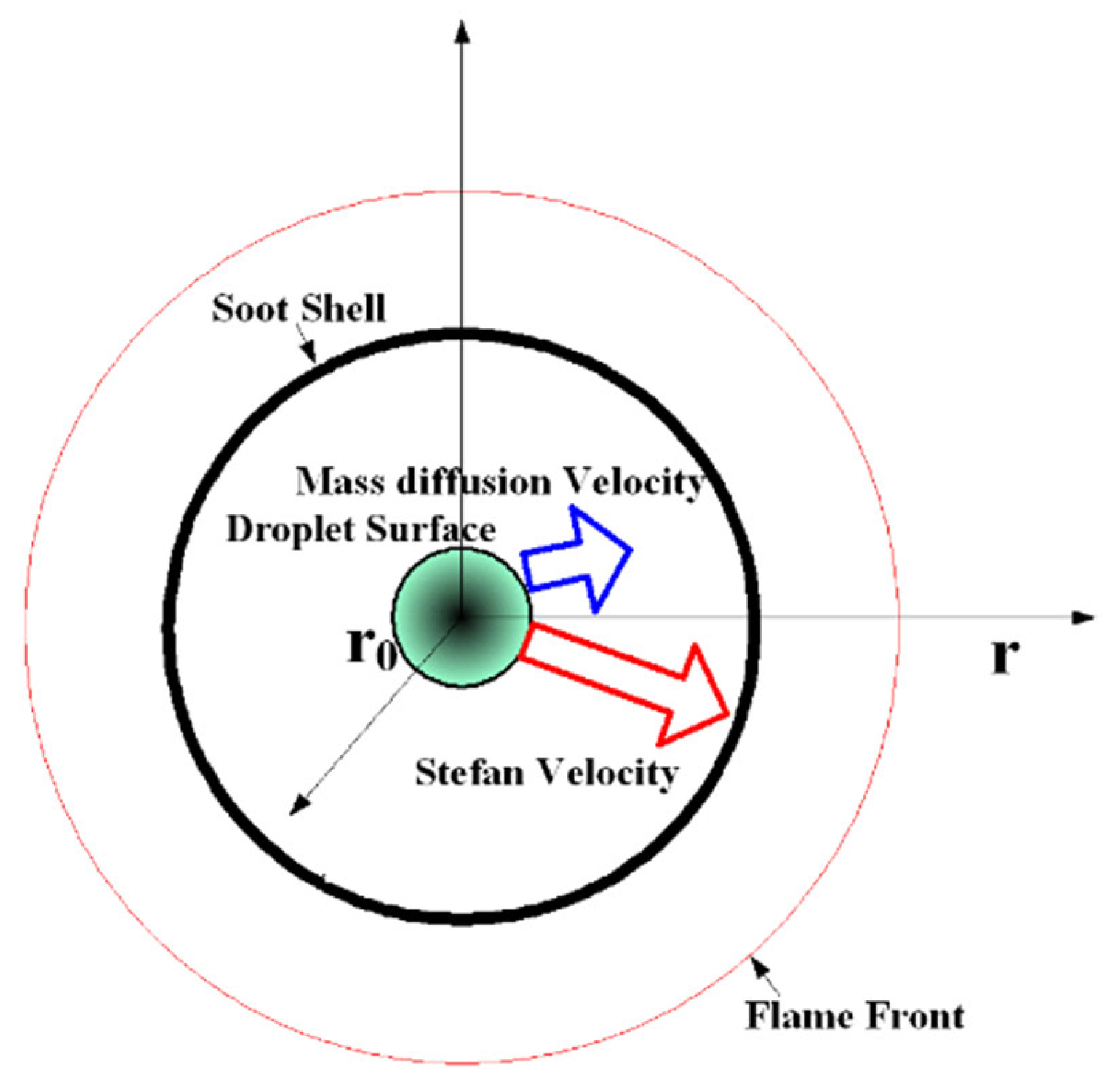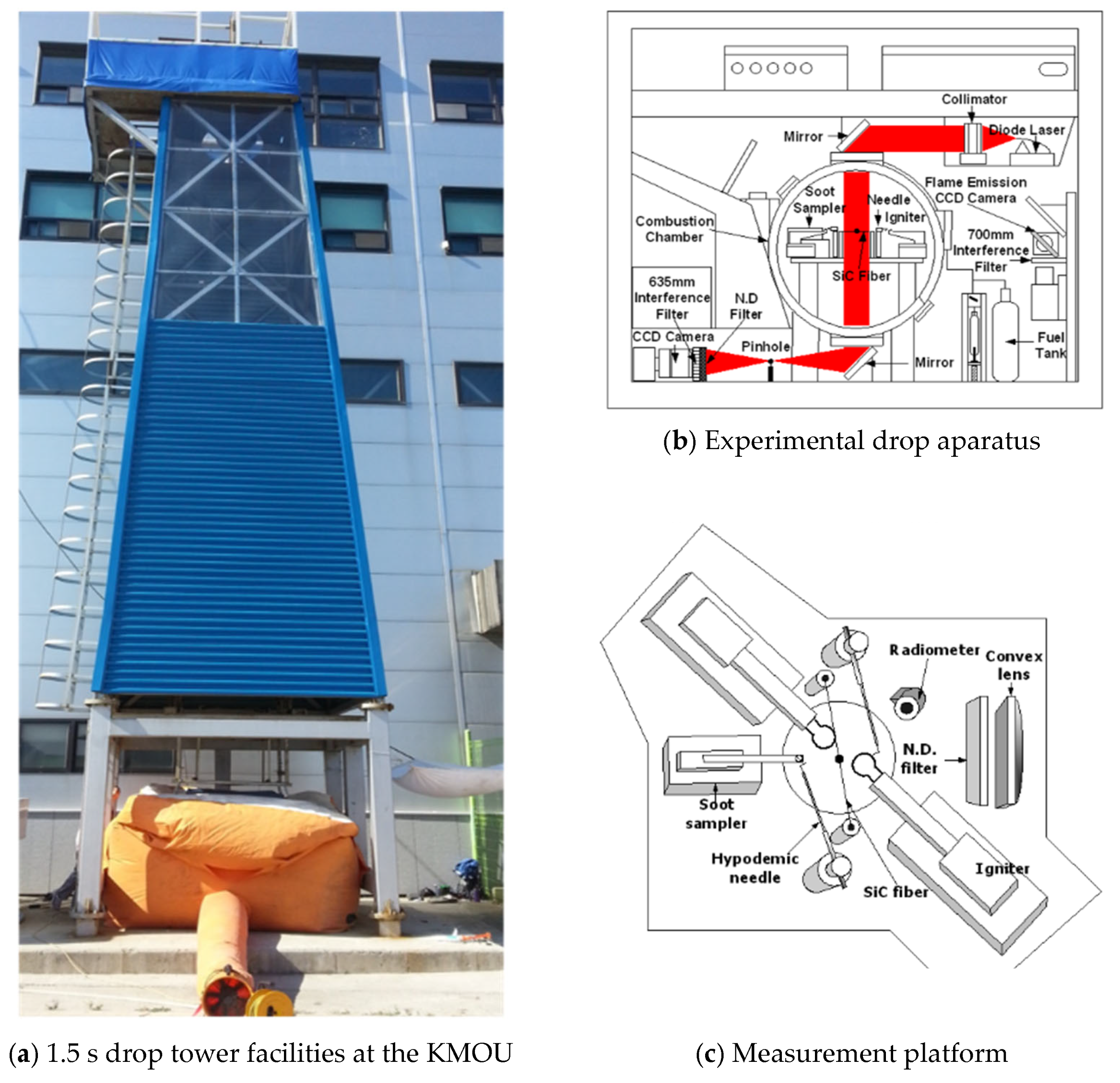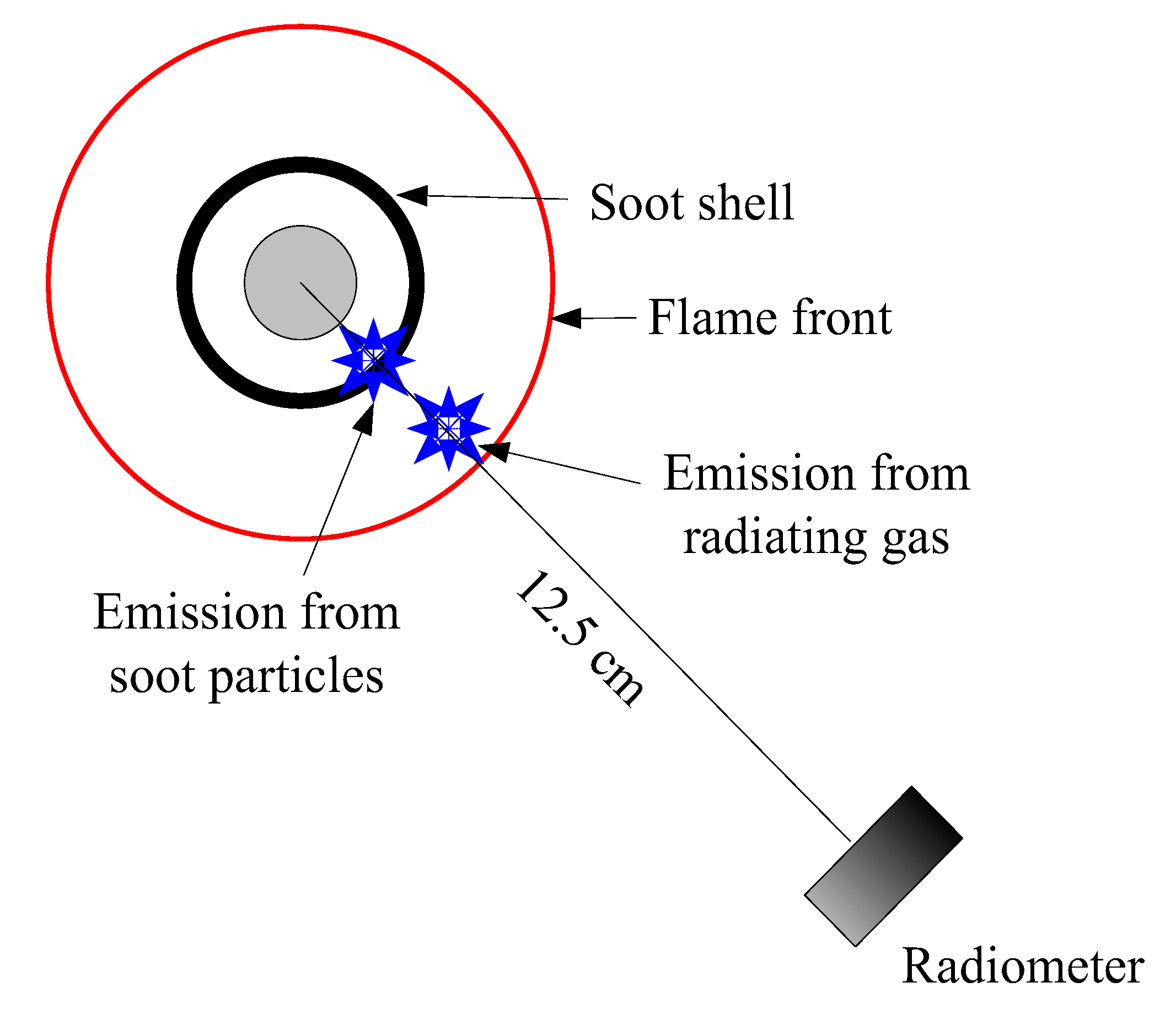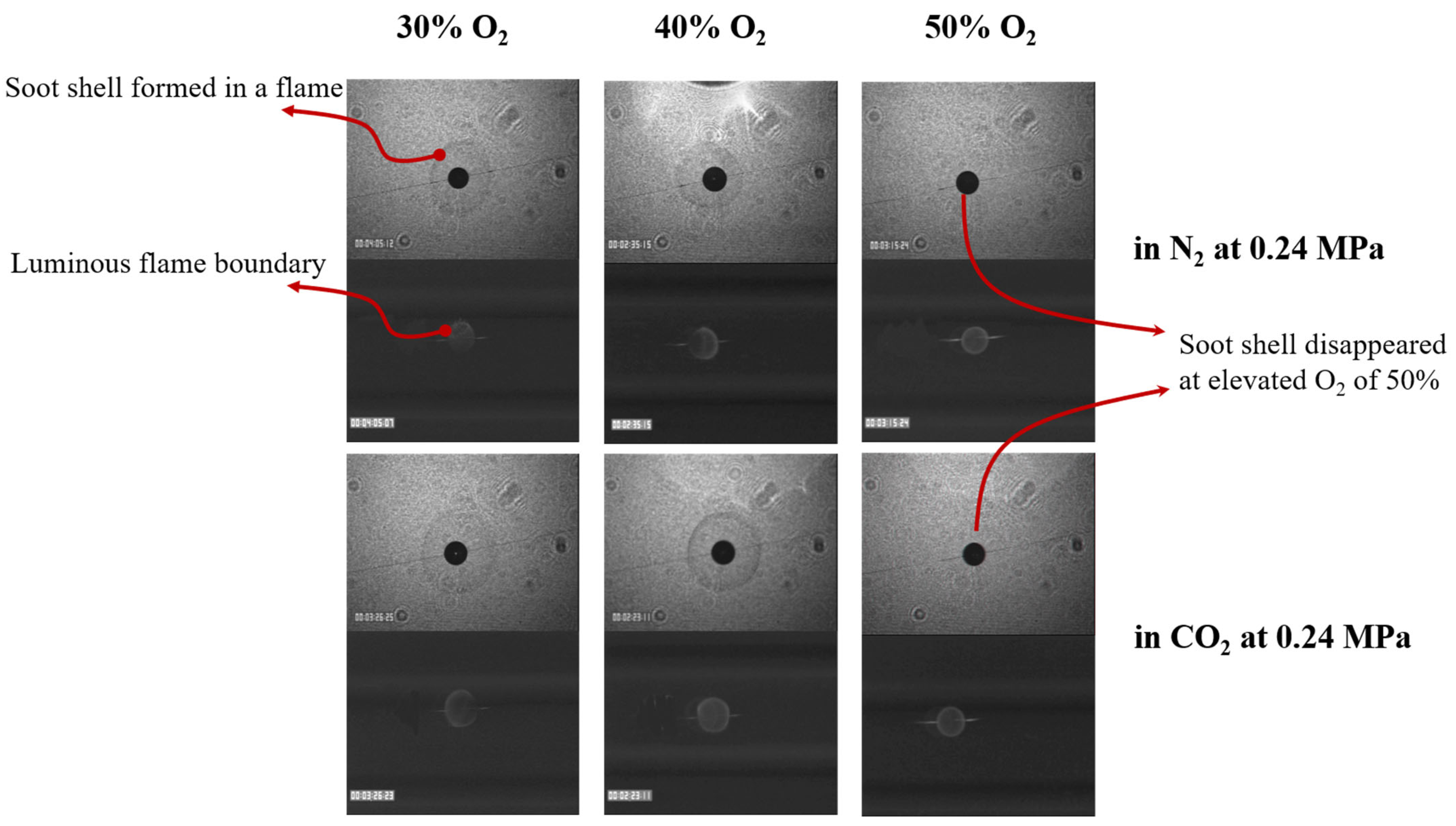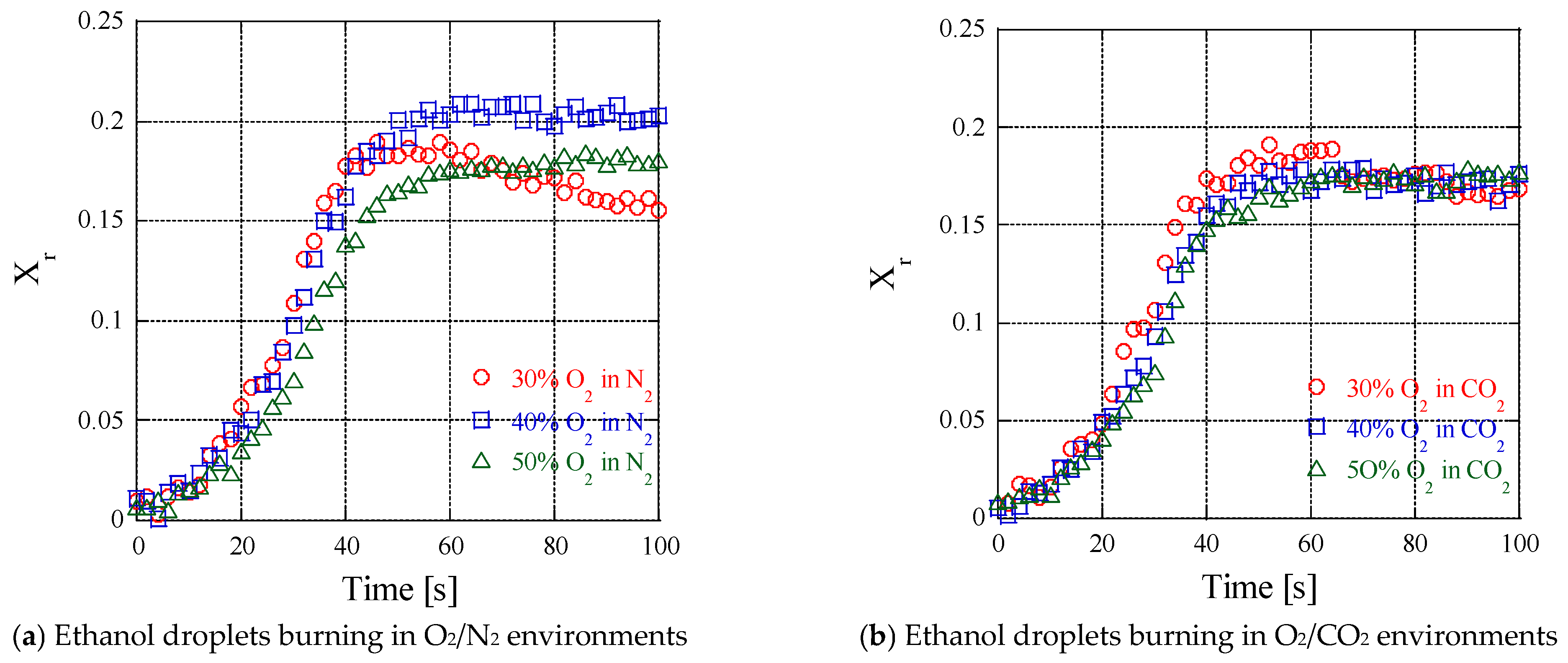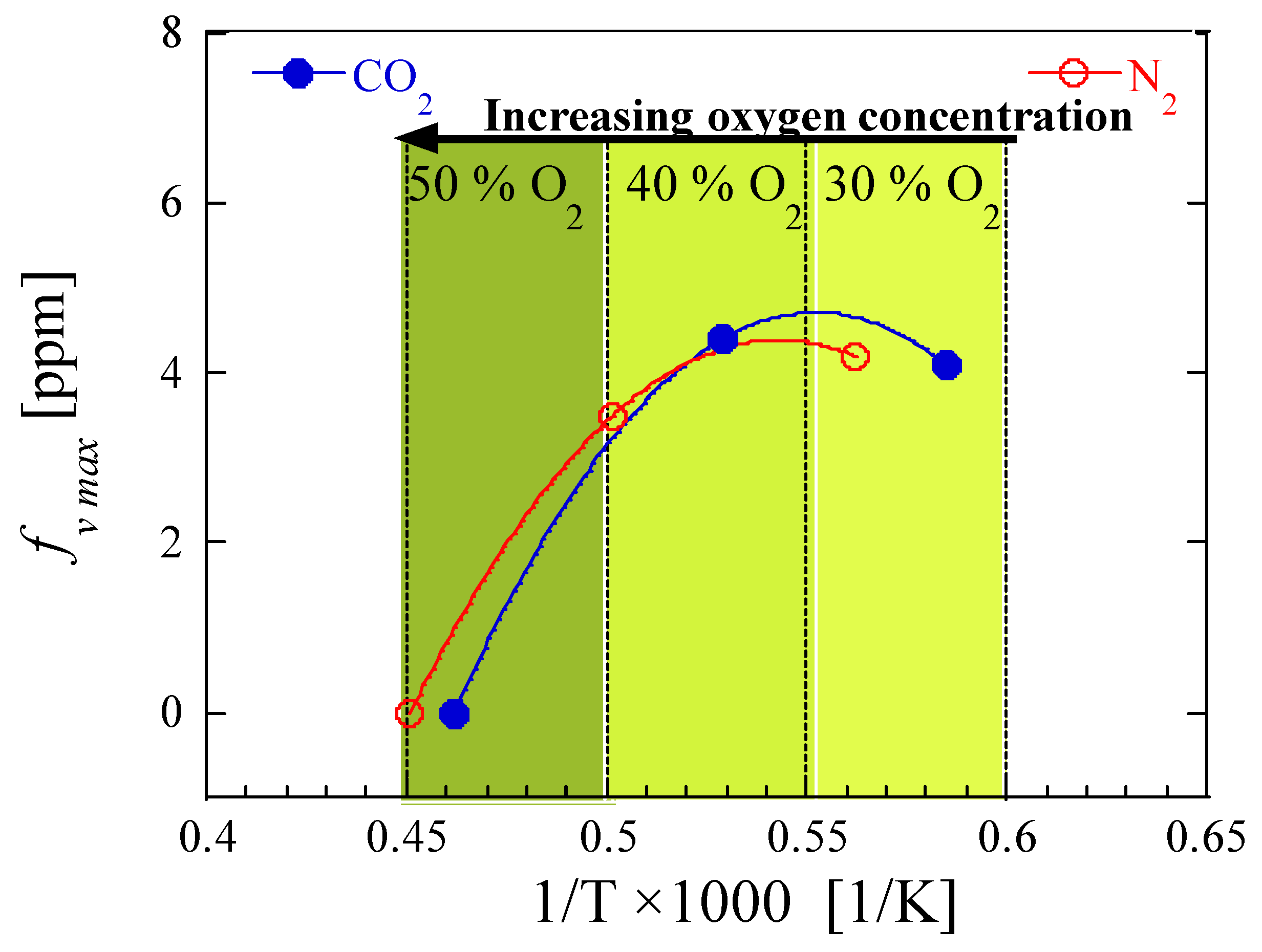1. Introduction
The safety of manned spacecraft for long-term space missions is critical, especially in terms of fire safety. In most terrestrial applications, the use of gaseous CO
2 is well recognized as an effective method of fire suppression [
1,
2,
3,
4,
5]. Because CO
2 scrubbing systems are required for manned spacecraft or interplanetary habitats, future extraterrestrial fire suppression systems also consider the gaseous CO
2 that is currently used in the ISS fire suppression system [
6,
7]. Previous investigations [
8] on flame spread over solid fuel beds have demonstrated that CO
2 is less effective as a diluent in microgravity than N
2 or He for both thermally thin and thermally thick fuels. In microgravity, the gaseous CO
2 around the flame absorbs radiative energy and thus raises the temperatures of the surrounding gases, which are not convected away due to the absence of buoyant forces, resulting in greater energy feedback to the fuel. In this regard, the radiative feedback effects of CO
2 make it an unsuitable choice as a gaseous fire suppression agent. In a recent computational analysis of cup-burner flames in microgravity, radiative loss was found to be a key loss mechanism in thermal quenching, and the minimum extinguishing concentration (MEC) of the CO
2 environment increased by 32% compared to identical flames in normal gravity [
9]. The results of the cup-burner configuration imply that different physicochemical mechanisms exist depending on whether the additional CO
2 is present on the fuel or the oxidizer side of the flame. These findings imply that each of the experimental flame configurations has its own advantages and that a more thorough understanding of the CO
2 radiation impacts in microgravity can be acquired by comparing multiple flame configurations. In this study, a classic droplet configuration [
10,
11,
12,
13] was employed as a research platform for spacecraft fires to examine the effect of CO
2 on droplet burning.
The influence of ambient CO
2 on droplet flames in microgravity has been investigated experimentally and numerically. Hicks and coworkers [
14] reported on the effects of CO
2 around a methanol droplet flame on its burning behavior and its subsequent extinction. They emphasized that ambient CO
2 reduces diffusivity and flame temperature, lowering the burning rate constant, which is clearly observed as a simultaneous reduction in radiative energy output. They also found that larger reductions in the water diffusion coefficient of the methanol droplet flame resulted in a small reduction in the extinction flame diameter. These findings are clearly supported by the subsequent numerical investigations performed by Farouk and Dryer [
15]. In their further investigation [
16], the effect of ambient CO
2 on droplet flame extinction showed a dramatic transition in the extinction of the larger droplet sizes (>1.5 mm) due to a shift in the extinction mechanism from diffusive to radiative control. Although these investigations contribute to a better understanding of the effects of ambient CO
2 on the burning and extinction of non-sooting methanol droplet flames, which are more affected than other fuels by water absorption, the radiative extinction effects observed in these investigations may differ from those observed in sooting droplet flames.
Recent n-alkane droplet combustion experiments in microgravity onboard the International Space Station (ISS) [
17] have shown that increased ambient CO
2 causes a higher fraction of heat loss through radiation compared to heat release, causing the flame temperature to rapidly fall to the critical extinction temperature, which leads to earlier flame extinction. Previous studies [
18] have reported that n-alkane fuels exhibit strong sooting tendencies in microgravity. However, the results obtained from the n-alkane droplet combustion experiments carried out onboard the ISS [
17] did not account for the significant radiative emissions from the soot formed in the droplet flame. Therefore, the objective of this study is to analyze and provide a comprehensive set of experiments to help elucidate the effect of the radiant emission of CO
2 gas coupled with the sooting behavior of microgravity droplet flames. To this end, a variety of measurements including droplet burning rate, flame temperature, soot-volume fractions, and radiative emissions were performed in microgravity for ethanol droplets burning in N
2 and CO
2 environments. Ethanol was chosen as the droplet fuel for this study because it allows for a broad range of sooting. Previous studies [
19] have shown that the burning of ethanol droplets in microgravity produces soot when higher ambient pressure is combined with higher oxygen concentrations. Once sooting begins at the higher flame temperature (afforded by the oxygen concentration variations) and ambient pressure, the observed sooting trends of ethanol are similar to those observed for n-alkane fuels such as n-heptane [
20] and n-decane [
21].
2. Experimental Descriptions
A series of drop experimental campaigns were carried out using the 1.5 s drop tower facilities (see
Figure 1a) at the Korea Maritime and Ocean University (KMOU). The schematic diagram of the experimental drop apparatus is shown in
Figure 1b. When the experimental drop apparatus is released from the top of the drop tower facilities, it experiences microgravity for approximately 1.5 s. The experimental drop apparatus illustrated in
Figure 1b,c comprises a 12 L combustion chamber with five optical access windows, a diode laser, a beam expander and collimator, high-resolution CCD cameras, and electro-mechanical components on the platform inside the combustion chamber. This platform is designed to take autonomous measurements of several parameters such as the soot-volume fraction, the flame temperature, the flame radiative emission, and the droplet burning rate of an isolated droplet flame in microgravity. Only a brief summary of the experimental drop apparatus and measurement technique are provided here since more information can be obtained elsewhere [
22].
The liquid ethanol was delivered from a fuel reservoir through two hypodermic needles using a 1.0 mL solenoid-activated syringe (0.25 mm in diameter). The ethanol dispensed from the hypodermic needles formed a droplet on a 15 μm silicon carbide (SiC) filament (which was used to tether the droplet to keep it from moving out of the field of view). Two horizontally opposed hot-wire igniters were used to ignite the liquid droplet during the free fall. The laser-backlit diagnostic equipment for measurements of the droplet burning rate and soot-volume fractions is the most critical component. In this equipment, the laser beam produced using a 635 nm diode laser was expanded to 50 mm in diameter and was then collimated. The expanded and collimated laser beam was redirected through the top optical port. The laser beam passing through the combustion chamber was focused using a 200 mm focal length plano-convex lens fitted to the bottom optical port. The focused laser beam was then reflected toward a high-resolution CCD camera. In front of the CCD camera, a zoom lens with a bandwidth filter for a wavelength of 635 nm was applied to obtain the required magnification for the spatially resolved droplet and the soot-containing region.
To measure the droplet burning rate, the laser-backlit images of the droplet were captured and then digitized frame by frame with high-resolution frame acquisition software. In this study, the droplet burning rate constant K was experimentally determined by measuring the regression of the square of the droplet diameter over time. A full-field light-extinction and tomographic inversion technique was applied to measure the soot-volume fraction distributions within the flame. The projected light-extinction ratio distributions (the transmitted image divided by the incident image) obtained as a function of time were used to determine the soot-volume fraction fv using the three-point Abel deconvolution technique [
23]. The radiative emission from the flame was measured using a radiometer which was placed 12.5 cm from the droplet center, as shown in
Figure 2. The spectral response of the radiometer ranges from 1 μm to 20 μm, which covers the majority of the radiation emitted from the broadband via the soot particles and the spectral radiation emitted by the radiating gases, such as CO
2 and H
2O.
Thin filament pyrometry (TFP), a method that has been extensively studied in previous studies on laminar diffusion flames [
24,
25], was used to determine the temperature of the droplet flame. The TFP technique involves measuring the radiation intensity from the SiC filament (the same filament used to tether the droplet) and determining the temperature of the measured gray-body emission from the SiC filament using the Planck equation. The emission from the SiC filament at 700 nm imaged using the high-resolution CCD camera is shown in
Figure 3a. Flame radii were determined by measuring the spatial extent of the maximum luminosity region of the SiC filament (see
Figure 3b).
3. Results
Figure 4 shows laser-backlit and flame images of the ethanol droplets burning in the O
2/N
2 and O
2/CO
2 environments (which were captured 0.5 s after ignition). For all of the experiments performed, the initial droplet diameter (of 1.8 ± 0.1 mm) was kept constant and the O
2 concentration was elevated from 30% to 50% at 0.24 MPa. A soot shell of varying opacity (which indicates the magnitude of the sooting propensity) formed around the ethanol droplet represented by a black solid circle in the laser-backlit images. The ethanol droplets burned in the 30% and the 40% O
2 concentrations produced a distinct soot shell with variations in the magnitude of the sooting propensity with time. It was also observed that the soot shell that formed in the 50% O
2 concentration quickly vanished after ignition. Increasing the O
2 concentration caused changes in flame luminosity over time, owing to variations in the thermal radiation emitted by the soot particles and the gases.
Figure 5 displays the results of the analysis of the droplet and flame histories of the ethanol droplets burning in 40% O
2 in the N
2 and CO
2 environments. In
Figure 5a, a linear fit to the evolution of the square of the droplet diameter d
2 over time after the transient heat-up period yielded the droplet burning rate K. The flame standoff ratio (FSR) computed by dividing the flame diameter by the instantaneous droplet diameter increased initially and then approached quasi-steady behavior over time. The measured droplet burning rates K and average FSRs (determined from the quasi-steady state) for the experiments in
Figure 4 were plotted as a function of O
2 concentration, as shown in
Figure 5b.
In all of the experiments performed at O
2 concentrations ranging from 30% to 50%, the burning rates in the N
2 environments were higher than in the corresponding O
2 concentrations in the CO
2 environments. The lowered burning rate of ethanol in the CO
2 environments is primarily due to the higher heat capacity of CO
2 in comparison to N
2 (see
Figure 6; data obtained from the NIST Chemistry WebBook, SRD 69 [
26]). Previous investigations [
21] have clearly demonstrated that the increased heat losses caused through the radiative emission from the flame can influence the burning behavior of microgravity droplet flames. The radiative emission is proportional to the volume of the soot-containing flame which varies with inert substitution. In particular, the larger flame diameter in the CO
2 environments represents a larger volume of the radiatively participating medium comprising soot and gases such as CO
2 and H
2O which can result in higher heat losses from the flame and thus lower the droplet burning rate. However, as will be discussed later in
Figure 7, the measured radiative heat losses were slightly higher in the N
2 environment as compared with the CO
2 environment. This result implies that the reduction in the burning rate caused through the presence of the CO
2 around the droplet is solely attributable to the high specific heat of the CO
2 rather than the influence of radiative heat loss. Furthermore, the differences in heat capacity and flame volume do not fully explain why the burning rate of ethanol droplets in the N
2 environments increased non-linearly in the O
2 environments but linearly in the CO
2 environments.
To better understand the impact of radiative heat losses on burning behavior, the radiative heat loss fraction was calculated as follows:
where
Qm is the measured radiative emission power (mW) and
Qc is the rate of heat generation (mW). For each of the experiments performed,
Qc was calculated using the following equation:
where
ρl is the liquid density of the fuel (g/mm
3),
K is the average burning rate constant (mm
2/s), Δ
H is the heat of combustion per unit of mass of the fuel (J/g), and
d is the droplet diameter (mm).
Figure 7a,b shows the calculated radiative heat loss fractions as a function of time when the O
2 concentrations in the N
2 and the CO
2 environments vary from 30% to 50%. As shown in the figures, the radiative heat loss fraction rapidly increases and approaches the quasi-steady values in all of the experiments. The most dramatic change in radiative heat loss fractions with the O
2 concentrations happens in the N
2 environments. In the CO
2 environments, however, the increases in the O
2 concentrations have relatively little effect on the radiative heat loss fraction compared to in the N
2 environments. Interestingly, the radiative heat loss fraction observed in the N
2 environments increases as the O
2 concentration increases from 30% to 40% but falls drastically when the O
2 concentration reaches 50%. These intriguing phenomena are closely related to sooting behaviors along with the flame temperature variations. Since soot forms through pyrolysis reactions with a high activation energy [
22], the sooting behavior in diffusion flames is sensitive to changes in flame temperature. In an effort to quantitatively investigate the sooting behavior of ethanol droplet flames, the measured maximum flame temperatures T
f max and soot-volume fractions f
v max were summarized, as shown in
Table 1. For each experiment, the f
v max and the T
f max were determined from the time-varying distributions of the soot-volume fraction and the flame temperature measurements. The range of the T
f max for the N
2 varied from 1780 K to 2217 K, and for the CO
2, from 1710 K to 2165 K, as the O
2 concentration in the ambient atmosphere increases. The higher T
f max of the ethanol droplet flames in the N
2 environments was primarily due to the higher heat capacity of CO
2 with respect to N
2. Based on the differences in the heat capacity, the presence of CO
2 around the flame produced a lower T
f max, which was approximately 50 ~ 100 K lower than that of N
2. The measured f
v max ranges from 3.5 ppm for the 40% O
2 concentration in the N
2 environment (the lowest value) to 4.4 ppm for the 30% O
2 concentration in the CO
2 environment (the highest value). Despite the slightly lower flame temperatures in the CO
2 environment compared to the N
2 environment, the CO
2 environment exhibited similar sooting behavior to that seen in the N
2 environment (in terms of f
v max measured as a function of O
2) due to the longer residence time of fuel vapor (τ
r), as shown in
Table 1. The longer the residence time of the fuel molecules in a high-temperature environment, the greater the potential for sooting enabled through fuel pyrolysis, nucleation, and surface growth [
22]. In this study, the residence time of the fuel vapor within the region bounded by means of the droplet surface and the flame front was calculated using the formulation suggested in the authors’ previous works (see
Appendix A for more details).
Figure 8 displays the measured f
v max plotted with respect to the inverse of T
f max. The measured f
v max initially increased, reached a maximum, and then promptly decreased with the increasing O
2 concentrations in both the N
2 and the CO
2 environments, as shown in the figure. These interesting non-monotonic behaviors of f
v max with the increased O
2 concentrations are linked to the competition between the pyrolysis reactions leading to the soot precursors and the onset of fragmentation of the formed soot precursors influenced by the temperature, as well as the oxidation of the soot precursors and the particles [
22]. Because the pyrolysis reactions are rate-controlling at lower temperatures, the f
v max increased with temperature. As the temperature increased beyond the threshold value, however, the formed soot precursors fragmented due to the decrease in their thermodynamic stability, thereby reducing the soot yield. As the O
2 concentration in the ambient environment is elevated, there is also expected to be greater degrees of leakage of OH radicals across the flame front towards the fuel-rich region which can enhance the oxidation of the soot precursors and the soot particles [
22]
More importantly, the non-monotonic behaviors of f
v max appeared to have a significant impact on variations in the magnitude of radiative heat loss in the N
2 environment with the increased O
2. Despite reductions in the f
v max from the increasing O
2 concentration from 30% to 40%, the magnitude of the radiative emissions from the soot particles increased due to the comparatively high flame temperature, as shown in
Figure 6a. However, the magnitude of the radiative emissions was reduced through increasing the O
2 concentration up to 50% regardless of the flame temperature, as the soot particles disappeared within the flame. In contrast to the N
2 environment, the magnitude of the radiative emissions in the CO
2 environments was nearly identical despite the non-monotonic f
v max behaviors produced through the increasing O
2. Because CO
2 (which is not convected away due to the lack of buoyant flow) is a radiatively participating gas, it absorbed radiative energy from the flame and thus increased the temperatures of the surrounding gases. As a result, the CO
2 around the flame in microgravity provides an increased optical thickness, compared to in normal gravity, eventually blocking radiation emissions from the flame to the surroundings.
